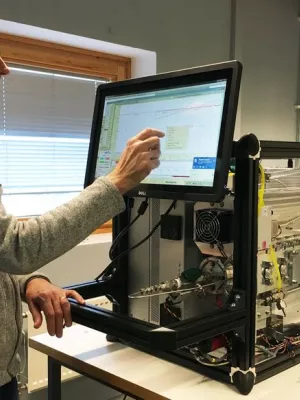
Erik Swietlicki
Professor

Is Levoglucosan a Suitable Quantitative Tracer for Wood Burning? - Comparison with Receptor Modeling on Trace Elements in Lycksele, Sweden
Author
Summary, in English
Particle emissions from residential wood combustion in small communities in Northern Sweden can sometimes increase the ambient particle concentrations to levels comparable to densely trafficked streets in the center of large cities. The reason for this is the combination of increased need for domestic heating during periods of low temperatures, leading to higher emission rates, and stable meteorological conditions. In this work, the authors compare two different approaches to quantify the wood combustion contribution to fine particles in Northern Sweden: a multivariate source-receptor analysis on inorganic compounds followed by multiple linear regression (MLR) of fine particle concentrations and levoglucosan used as a tracer. From the receptor model, it can be seen that residential wood combustion corresponds with 70% of modeled particle mass. Smaller contributions are also seen from local nonexhaust traffic particles, road dust, and brake wear (each contributing 14%). Of the mass, 1.5% is explained by long-distance transported particles, and 2% derives from a regional source deriving from either oil combustion or smelter activities. In samples collected in ambient air, a significant linear correlation was found between wood burning particles and levoglucosan. The levoglucosan fraction in the ambient fine particulate matter attributed to wood burning according to the multivariate analysis ranged from < 2% to 50%. This is much higher than the fraction found in the emission from the boilers expected to be responsible for most emissions at this site (between 3% and 6%). A laboratory emission study of wood and pellet boilers gave 0.3%(wt) to 22%(wt) levoglucosan to particle mass, indicating that the levoglucosan fraction may be highly dependent on combustion conditions, making it uncertain to use it as a quantitative tracer under real-world burning conditions. Thus, quantitative estimates of wood burning contributions will be very uncertain using solely levoglucosan as a tracer.
Department/s
- Nuclear physics
Publishing year
2006
Language
English
Pages
1669-1678
Publication/Series
Journal of the Air and Waste Management Association
Volume
56
Issue
12
Links
Document type
Journal article
Publisher
Taylor & Francis
Topic
- Subatomic Physics
Status
Published
Research group
- Aerosol, Nuclear Physics
ISBN/ISSN/Other
- ISSN: 1096-2247